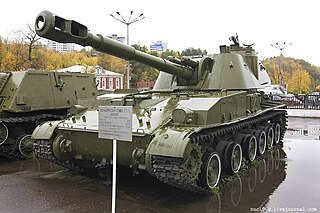 W
WThe SO-152 is a Soviet 152.4 mm self-propelled gun developed in 1968. It was a response to the American 155 mm M109. The development started in 1967 according to the Resolution of the Council of Ministers of the Soviet Union from July 4, 1967. In 1968 the SO-152 was completed and in 1971 entered service. Its GRAU designation is 2S3 (2С3). The fighting vehicle also received the additional designation Akatsiya (Акация), which is Russian for acacia.
 W
WThe 2S19 "Msta-S" is a 152.4 mm self-propelled howitzer designed by Soviet Union, which entered service in 1989 as the successor to the 2S3 Akatsiya. The vehicle is based on the T-80 tank hull, but is powered by the T-72's diesel engine.
 W
WThe 2S35 Koalitsiya-SV is a Russian self-propelled gun first seen in public in 2015 during rehearsals for the Moscow Victory Day Parade. The 2S35 is expected to supplement and eventually replace the 2S19 Msta in the Russian Ground Forces.
 W
WThe AHS Krab is a 155 mm NATO-compatible self-propelled tracked gun-howitzer designed in Poland by Centrum Produkcji Wojskowej Huta Stalowa Wola, by combining the South Korean K9 Thunder chassis with a British AS-90M Braveheart turret with 52-calibre gun and WB Electronics' "Topaz" artillery fire control system. The 2011 version used a Nexter Systems barrel and UPG chassis. The 2016 production batch utilize the K9 chassis and a Rheinmetall barrel. As of 2016 full-rate production of 120 Krabs for Polish Army has started with 16 guns completed and deliveries to be completed by 2024.
 W
WThe Artillery Gun Module is an air-portable self-propelled howitzer designed by Krauss-Maffei Wegmann. It is based on technology used in the German Army Panzerhaubitze 2000 system, to provide more air portable self-propelled artillery, transportable by Airbus A400 aircraft.
 W
WThe AS-90, known officially as Gun Equipment 155 mm L131, is an armoured self-propelled artillery weapon used by the British Army.
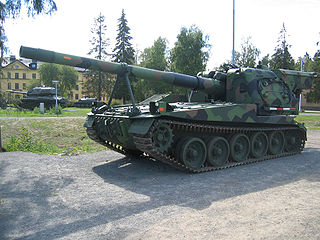 W
WThe Bandkanon 1, abbreviation bkan 1, was a Swedish self-propelled artillery vehicle in use with the Swedish Army from 1967 to 2003. Bkan 1 was one of the world's heaviest and most powerful self-propelled artillery vehicles in use during its service.
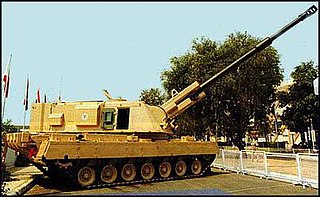 W
WThe Bhim self-propelled howitzer is a type of self-propelled artillery developed by the South African company Denel under the supervision of the Indian Defence Research and Development Organisation. It was designed to meet the Indian Army's requirements for self-propelled artillery units. The howitzer is named after Bhima, one of the main protagonists and brother to Arjun of the Indian epic "Mahabharata".
 W
WThe Centurion was the primary British Army main battle tank of the post-World War II period. Introduced in 1945, it is widely considered to be one of the most successful post-war tank designs, remaining in production into the 1960s, and seeing combat in the front lines into the 1980s. The chassis was also adapted for several other roles, and these have remained in service to this day. It was a very popular tank with good armour, maneuverability, and gun.
 W
WThe Centurion was the primary British Army main battle tank of the post-World War II period. Introduced in 1945, it is widely considered to be one of the most successful post-war tank designs, remaining in production into the 1960s, and seeing combat in the front lines into the 1980s. The chassis was also adapted for several other roles, and these have remained in service to this day. It was a very popular tank with good armour, maneuverability, and gun.
 W
WFV433, 105mm, Field Artillery, Self-Propelled "Abbot" is the self-propelled artillery, or more specifically self-propelled gun (SPG), variant of the British Army FV430 series of armoured fighting vehicles (AFVs), using much of the chassis of the FV430 but with a fully rotating turret at the rear housing the 105 mm gun and given the vehicle designation of FV433.
 W
WThe AMX-30 AuF1 is a French self-propelled gun vehicle currently in use by the armies of France and Saudi Arabia. It replaced the former Mk F3 155mm in French Army service. The AuF1 primary advancement is that it incorporates and provides full armor and nuclear-biological-chemical (NBC) protection for its crew of four, while the former Mk F3 155mm offered no protection and could carry only two of its four crew members. The AuF1 saw combat with the Iraqi Army in the Iran–Iraq War.
 W
WThe 75 mm Howitzer Motor Carriage M8 was a self-propelled howitzer vehicle of the United States in use during World War II. It was developed on the chassis of the M5 Stuart tank and was equipped with a M116 howitzer in an M7 mount.
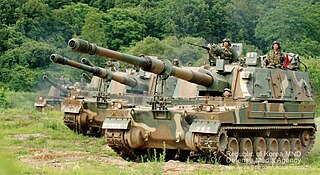 W
WThe K9 Thunder is a South Korean self-propelled 155 mm howitzer designed and developed by the Agency for Defense Development and Samsung Aerospace Industries for the Republic of Korea Armed Forces, and is now manufactured by Hanwha Defense. K9 howitzers operate in groups with the K10 automatic ammunition resupply vehicle variant. The entire K9 fleet operated by the ROK Armed Forces is now undergoing upgrades to K9A1 standard, and a further development of a K9A2 variant is in process.
 W
WThe M-1978 Koksan is a 170 mm self-propelled gun of North Korean design and manufacture. Very little information is available due to the secretive nature of the North Korean government. The designations M-1978 and Koksan were given to the type by US military analysts, as they first became aware of it in that year in Koksan, North Korea.
 W
WThe Kliment Voroshilov (KV) tanks are a series of Soviet heavy tanks named after the Soviet defence commissar and politician Kliment Voroshilov who operated with the Red Army during World War II. The KV tanks were known for their heavy armour protection during the early stages of the war, especially during the first year of the German invasion of the Soviet Union. In certain situations, even a single KV-1 or KV-2 supported by infantry could halt German formations. The German Wehrmacht at that time rarely deployed its tanks against KVs, as their own armament was too poor to deal with the "Russischer Koloss" – "Russian Colossus".
 W
WThe Kliment Voroshilov (KV) tanks are a series of Soviet heavy tanks named after the Soviet defence commissar and politician Kliment Voroshilov who operated with the Red Army during World War II. The KV tanks were known for their heavy armour protection during the early stages of the war, especially during the first year of the German invasion of the Soviet Union. In certain situations, even a single KV-1 or KV-2 supported by infantry could halt German formations. The German Wehrmacht at that time rarely deployed its tanks against KVs, as their own armament was too poor to deal with the "Russischer Koloss" – "Russian Colossus".
 W
WThe M-46 Catapult was a self-propelled gun developed in India by Combat Vehicles Research & Development Establishment of the Defence Research & Development Organisation.
 W
WThe 105 mm Howitzer Motor Carriage M7 was an American self-propelled artillery vehicle produced during World War II. It was given the official service name 105 mm Self Propelled Gun, Priest by the British Army, due to the pulpit-like machine gun ring, and following on from the Bishop and the contemporary Deacon self-propelled guns.
 W
WThe 155 mm Gun Motor Carriage M12 was a U.S. self-propelled gun developed during the Second World War. It mounted a 155 mm gun derived from the French Canon de 155mm GPF field gun.
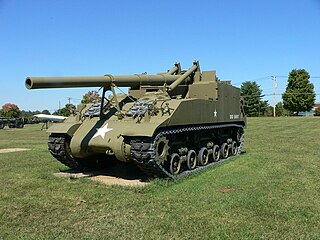 W
WThe 155 mm Gun Motor Carriage M40 was an American self-propelled artillery vehicle built on a widened and lengthened Medium Tank M4A3 chassis, but with a Continental engine and with HVSS, which was introduced at the end of the Second World War.
 W
WThe 155 mm Howitzer Motor Carriage M41 was an American self-propelled artillery vehicle built on a lengthened M24 Chaffee tank chassis that was introduced at the end of the Second World War. Out of a planned run of 250, only 85 were produced before cancellation of the order at the end of 1945. The M41 went on to serve extensively in the Korean War, its success influencing the design of later U.S. self-propelled artillery. The type was retired after the conclusion of that conflict, but went on to serve briefly in the French Army.
 W
WThe 203 mm Howitzer Motor Carriage M43 was an American self-propelled artillery vehicle built on a widened and lengthened Medium Tank M4A3 chassis, but with a Continental engine and HVSS that was introduced at the end of the Second World War. The M43 shared the same chassis as the more widely produced M40 Gun Motor Carriage, which instead mounted a 155 mm gun, and were designed by the Pressed Steel Car Company. A production run of 576 was planned originally, but in the end only 24 were produced and another 24 were converted from M40 hulls. The M43 went on to serve in the Korean War, and was retired after its conclusion.
 W
WThe M44 was an American-made self-propelled 155 mm howitzer based on the M41 Walker Bulldog tank chassis, first introduced in the early 1950s. Flaws in its design prevented it from seeing action in the Korean War, but the type went on to serve in the U.S., West German, Italian and British Armies into the 1960s, and even longer in Turkish service.
 W
WThe M55 is an American fully enclosed and armored self-propelled artillery based on the M53 155 mm self-propelled artillery. It has a 203.2 mm (eight-inch) howitzer which can traverse 30° left or right, carrying 10 rounds of ammunition when fully combat loaded. The gun has a maximum range of 10.51 miles with a rate of fire of one round every two minutes. The M55 is lightly armored, 25 mm maximum, but sufficient to protect the crew from indirect artillery hits and small arms fire.
 W
WThe M107 175 mm self-propelled gun was used by the U.S. Army from the early 1960s through to the late 1970s. It was part of a family of self-propelled artillery that also included the M110. It was intended to provide long-range fire support in an air-transportable system. It was exported to several other countries including Germany, South Korea, Spain, Greece, Iran, Israel, Italy, the Netherlands, the United Kingdom, and Turkey. The M107's combat history in U.S. service was limited to the Vietnam War; it also saw extensive combat use in Israeli service. The M107 shared many components with, and in many cases was replaced by, later versions of the M110 203 mm howitzer. Although withdrawn from U.S. service in the late 1970s, it continues in service with some armies as of 2019.
 W
WThe M108 Howitzer is an American self-propelled 105 mm howitzer, first introduced in the early 1960s as a replacement for the M52 self-propelled howitzer.
 W
WThe M109 is an American 155 mm turreted self-propelled howitzer, first introduced in the early 1960s to replace the M44. It has been upgraded a number of times, most recently to the M109A7. The M109 family is the most common Western indirect-fire support weapon of maneuver brigades of armored and mechanized infantry divisions.
 W
WThe 8 inch (203 mm) M110 self-propelled howitzer is an American-made self-propelled artillery system consisting of an M115 203 mm howitzer installed on a purpose-built chassis. Before its retirement from US service, it was the largest available self-propelled howitzer in the United States Army's inventory; it continues in service with the armed forces of other countries, to which it was exported. Missions include general support, counter-battery fire, and suppression of enemy air defense systems.
 W
WThe 155 mm self-propelled gun Mk F3, or the Canon de 155 mm Mle F3 Automoteur (Cn-155-F3-Am), was developed in the early 1950s by the French Army to replace their American M41 Gorilla 155mm self-propelled guns. The Mk F3 is the smallest and lightest 155 mm motorized gun carriage ever produced, and because of its size and low cost it has found considerable success on the export market. Constructed on a modified AMX-13 light tank chassis, the Mk F3 is novel in incorporating room inside for only two of the eight required crewmen. This allows the 155 mm gun to be placed on a smaller chassis than that employed by other armies, but exposes the outside crew members to enemy fire and other hazards.
 W
WThe Palmaria is an Italian self-propelled howitzer using the 155 mm (6.1″) NATO-standard artillery calibre.
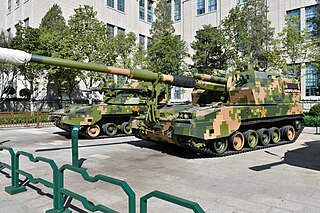 W
WThe PLZ-05 or the Type 05 is a 155 mm self-propelled howitzer developed by the People's Liberation Army of China to replace the Type 59-1 130mm. The PLZ-05 was officially unveiled at the Military Museum of the Chinese People's Revolution to mark the 80th anniversary of the PLA in July 2007, and first entered service with the PLA in 2008.
 W
WThe PLZ-07 or Type 07 is a Chinese 122 mm self-propelled artillery made by the China North Industries Group Corporation (NORINCO). The PLZ-07 self-propelled howitzer was first unveiled to the public during the military parade celebrating 60th anniversary of the PLA on 1 October 2009. The PLZ-07 was developed to replace the older Type 89, Type 85 and Type 70/70-1 122 mm self-propelled artillery systems.
 W
WThe PLZ-45 or Type 88 is a 155 mm self-propelled howitzer designed by Su Zhezi of 674 Factory, and developed by Norinco, 123 Factory, 127 Factory, 674 Factory and Beijing Institute of Technology in the early 1990s for the export market. It is based on Norinco's Type 89 (PLL01) 155mm/45-calibre towed gun-howitzer.
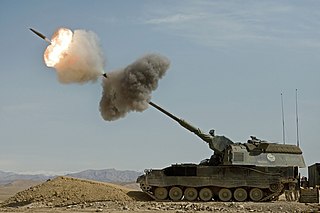 W
WThe Panzerhaubitze 2000, abbreviated PzH 2000, is a German 155 mm self-propelled howitzer developed by Krauss-Maffei Wegmann (KMW) and Rheinmetall for the German Army. The PzH 2000 is one of the most powerful conventional artillery systems deployed in the 2010s. It is capable of a very high rate of fire; in burst mode it can fire three rounds in nine seconds, ten rounds in 56 seconds, and can—depending on barrel heating—fire between 10 and 13 rounds per minute continuously. The PzH 2000 has automatic support for up to 5 rounds of Multiple Rounds Simultaneous Impact (MRSI). The replenishment of shells is automated. Two operators can load 60 shells and propelling charges in less than 12 minutes. PzH 2000 has also been selected by the armies of Italy, Netherlands, Greece, Lithuania, Hungary, Qatar and Croatia, mostly replacing older systems like the M109 howitzers.
 W
WSP70 self-propelled gun was a scheme set up by several European nations including the UK, Germany and Italy beginning in 1973. The project was shelved in favour of the US M109, which was already in service. The SP70 was 'outgunned' on several occasions by the M109 and further development was cancelled in the 1980s.
 W
WThe Singapore Self-Propelled Howitzer 1 Primus is a self-propelled howitzer armed with a 155 mm howitzer. Developed jointly by the Singapore Armed Forces (SAF), Defence Science and Technology Agency (DSTA) and Singapore Technologies Kinetics, it was introduced to the Singapore Artillery in 2004. Primus is derived from the Artillery motto In Oriente Primus.
 W
WT-155 Fırtına is a Turkish 155 mm self-propelled howitzer co-developed with South Korea utilizing Turkish technology and design into existing K9 Thunder. It is manufactured and assembled by Turkish Land Forces at the 1010th Army Equipment Repair Factory using imported subsystems from Korea. It has an ongoing upgrade project dubbed as T-155 Fırtına II, possibly changing its engine to Ukraine origin to avoid Germany's restriction on Turkey's defense sales.
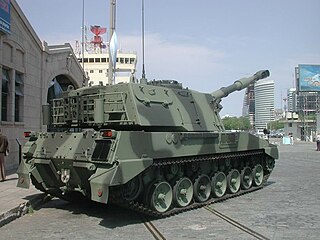 W
WThe VCA-155 is a self-propelled 155mm gun/howitzer, manufactured by TAMSE which entered service in the late 1990s.
 W
WThe Type 74 105 mm self-propelled howitzer is only used by Japan. It shares a number of automotive components with the Type 73 Armored Personnel Carrier which was developed during the same time. Komatsu developed the chassis, while the howitzer and turret were designed by Japan Steel Works. The first prototypes were completed in 1969–70. The howitzer was accepted for service in 1974.
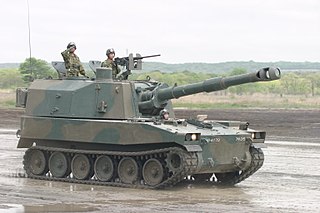 W
WThe Type 75 155 mm self-propelled howitzer is an armored artillery vehicle in the exclusive use of the Japan Ground Self-Defense Force. Self-propelled howitzers are employed to provide mobile heavy fire support to army units in the field.
 W
WThe Type 99 155 mm self-propelled howitzer is a self-propelled howitzer of the Japanese Ground Self-Defense Force, which was developed as successor of the Type 75 155 mm Self-propelled howitzer.
 W
WThe Kliment Voroshilov (KV) tanks are a series of Soviet heavy tanks named after the Soviet defence commissar and politician Kliment Voroshilov who operated with the Red Army during World War II. The KV tanks were known for their heavy armour protection during the early stages of the war, especially during the first year of the German invasion of the Soviet Union. In certain situations, even a single KV-1 or KV-2 supported by infantry could halt German formations. The German Wehrmacht at that time rarely deployed its tanks against KVs, as their own armament was too poor to deal with the "Russischer Koloss" – "Russian Colossus".
 W
WThe XM104 was a U.S.-developed self-propelled amphibious/air-droppable/heliborne 105 mm howitzer. Pilot models of the howitzer were built by the U.S. Army Ordnance Tank Automotive Command's Experimental Division at the Detroit Tank Arsenal shops, Warren, Mich.
 W
WThe XM2001 Crusader was to be the United States Army's next-generation self-propelled howitzer (SPH), designed to improve the survivability, lethality, mobility, and effectiveness of the artillery as well as the overall force. It was initially scheduled for fielding by 2008. United Defense was the prime contractor; General Dynamics the major subcontractor. In early May 2002, Secretary of Defense Donald Rumsfeld cancelled the US$11 billion program because he considered it neither mobile nor precise enough. The prototype SPH vehicle is on display at the cannon park at Fort Sill.
 W
WThe Kliment Voroshilov (KV) tanks are a series of Soviet heavy tanks named after the Soviet defence commissar and politician Kliment Voroshilov who operated with the Red Army during World War II. The KV tanks were known for their heavy armour protection during the early stages of the war, especially during the first year of the German invasion of the Soviet Union. In certain situations, even a single KV-1 or KV-2 supported by infantry could halt German formations. The German Wehrmacht at that time rarely deployed its tanks against KVs, as their own armament was too poor to deal with the "Russischer Koloss" – "Russian Colossus".